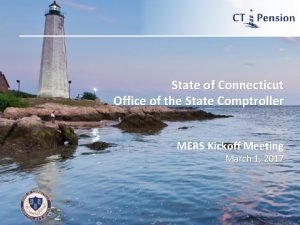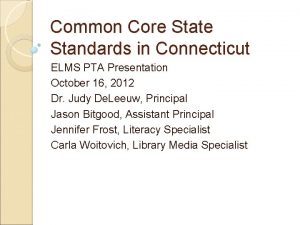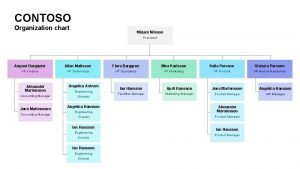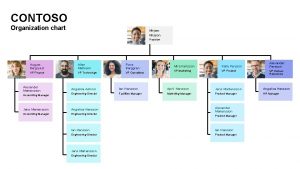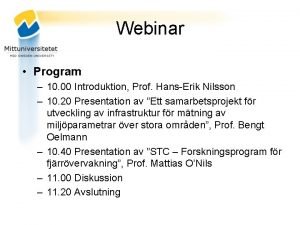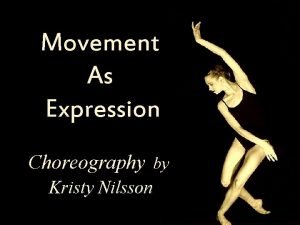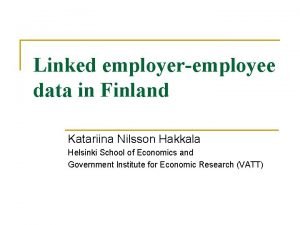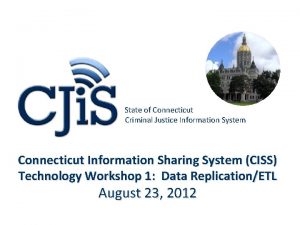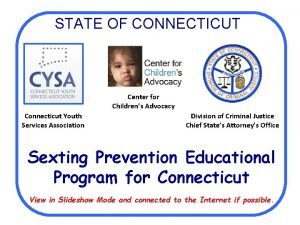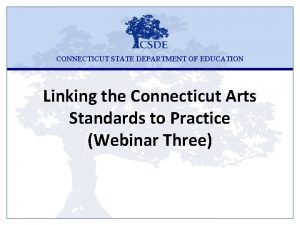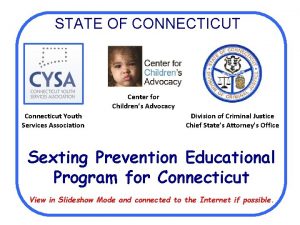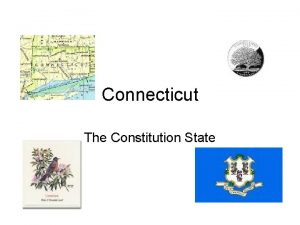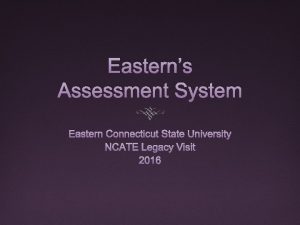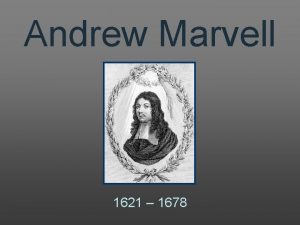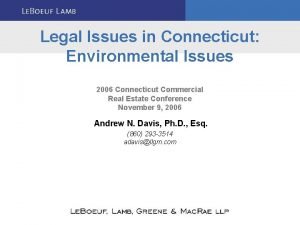Andrew T Nilsson Ph D Eastern Connecticut State

















- Slides: 17

Andrew T. Nilsson, Ph. D. Eastern Connecticut State University Copyright © Allyn & Bacon 2003

HUMAN DEVELOPMENT A LIFE STAGE PERSPECTIVE (Adulthood in blue) . Boy � ¨ adolescent � ¨ husband/worker � ¨ family head/career � ¨ grandfather � ¨ retired � ¨ death Girl � ¨ adolescent � ¨ wife � ¨ mother � ¨ grandmother � ¨ widow � ¨ death Copyright © Allyn & Bacon 2003

ERIKSON’S PSYCHO-SOCIAL CRISES AGE To 18 mo. ERIKSONIAN CRISIS Trust vs. mistrust 18 mo. - 3 yrs. 3 - 6 yrs. 6 -12 yrs. 12 -18 yrs. 20 -35 yrs. 35 -60 yrs. 65+ Autonomy vs. shame & doubt Initiative vs. guilt Industry vs. inferiority Identity vs. role confusion Intimacy vs. isolation Generativity vs. stagnation Ego integrity vs. despair DURATION 1 ½ yrs. 3 yrs. 6 yrs. 15 yrs. 25 yrs. ? • Developmental periods increase in duration • Individual differences increase as well Copyright © Allyn & Bacon 2003

ERIKSON’S STAGES OF ADULT DEVELOPMENT • 20 -35 yrs. - Intimacy vs. isolation – The quest for intimacy – the ability to share one’s self with another person without being afraid of sacrificing one’s own identity. – Love and work – mate selection and career choice • 35 -60 yrs, - Generativity vs. stagnation – The need to be creative and productive in ways which will contribute to future generations; creating one’s legacy for the future. Copyright © Allyn & Bacon 2003

DEVELOPMENTAL TASKS OF MID-LIFE Peck (1968) • Socializing vs. sexualizing – Redefine intimate relationships to value the individual, friendship, and compaionship, rather than sex alone. • Value wisdom vs. value physical power – Life experience and wisdom replaces phyical ability and attractiveness • Cathectic flexibility vs. cathectic impoverishment – The ability to shift one’s emotuional investment from one activity to another or from one individual to another • Mental flexibility vs. mental rigidity – Life-long learning; the ability to seek and adapt to new information and ideas Copyright © Allyn & Bacon 2003

LEVINSON’S STAGES OF ADULT LIFE The Seasons of a Man’s Life (1978) Copyright © Allyn & Bacon 2003

LEVINSON’S STAGES OF ADULT LIFE Levinson’s sample: • Levinson interviewed 40 men in four occupational groups (novelists, biologists, business executives, and factory workers) between the ages of 35 -45. Five percent were black. All had been married at least once. Copyright © Allyn & Bacon 2003

LEVINSON’S STAGES OF ADULT LIFE Levinson viewed life as a series of periods formed around developmental tasks, the main goals, objectives, and concerns faced by individuals during each life period. A period ends when its tasks lose significance and new tasks emerge. Developmental transitions: • Existing life structure • Transition period – period of personal crisis and re-evaluation – Life structure questioned; new decisions made • Review and evaluate the past • Accept loses at the end of a period • Explore new options – decide what to keep and what to discard; consider possibilities for the future • New life structure – Structure building period – relative tranquility – Structure based on new decisions Copyright © Allyn & Bacon 2003

STAGES OF ADULT LIFE EARLY ADULT TRANSITION (17 -22) • Move from pre-adulthood to adulthood – Graduation from school, move out of family home, go to work. – Independence from family. Financial and emotional autonomy. – College and military are transitional institutions – away from family but not total independence. – Make choices about how adult life will be lived • Men have a “dream, ” a vision of the future usually viewed in terms of career • Men have a “mentor, ” an older (8 -15 years) role model – someone with experience and seniority in the world the young adult wishes to enter. • Second important relationship – a woman who supports dream, makes man feel capable of obtaining it. Copyright © Allyn & Bacon 2003

LEVENSON – STAGES OF ADULT LIFE • Entering the adult world (22 -28) – Explore and make commitments to adult roles – establish life style – Work leads to career choice – Intimate relationships lead to marriage, birth of children • Age 30 transition (28 -33) – – Reappraisal of early adult commitments and change Focus on adjustment and enrichment “If I am to change my life, I’d better do it now. ” Sometimes crisis; divorce, occupational change common • Settling down (33 -40) – culminating life structure for early adulthood – Apprenticeship over – time to be a successful, competent adult – BOOM period – Becoming One’s Own Man – independence from mentor – Deeply absorbed in commitments to occupation, family, and activities – Desire to get ahead, realize youthful ambitions Copyright © Allyn & Bacon 2003

LEVENSON – STAGES OF ADULT LIFE • Midlife transition (40 -45) – – – Midlife crisis – “What have I done with my life? ” Come to terms with the dreams of one’s youth Work on discrepancy between what is and what will be Life takes on a new sense of urgency 80% of Levinson’s subjects went through personal crisis and re-evaluation – Crisis may include divorce, extramarital affair, occupational change Levinson stopped gathering data on his subjects at age 45. Copyright © Allyn & Bacon 2003

LEVENSON – STAGES OF ADULT LIFE • Entering middle adulthood (45 -50) – Living out previously made changes – For many, the most satisfying, enriching time of life • Age 50 transition (50 -55) – Time of moderate crisis – Men “review where they have come from and make plans for where they are heading. ” • Culmination of middle adulthood (55 -60) – Finish framework of life structure for middle adulthood – A period of great fulfillment • Late adult transition (60 -65) – Ending middle age and preparing for late adulthood Copyright © Allyn & Bacon 2003

APPLICATION OF LEVINSON’S THEORY TO WOMEN • Papulia and Olds (1992) study of dissertations: – The mentor - Women substantially less likely to have a mentor – Love relationship – Men seek women to support their dreams. Women seek a “special man” but see themselves as supporting his dreams. – The dream – Men find themselves by separating from family of origin and pursuing own interests. Women develop identities through responsibilities and attachments of relationships. – Men dream of occupational achievement, status accomplishment. Women – less clear dreams; more tentative mix of family and career interests. Copyright © Allyn & Bacon 2003

LEVINSON’S STUDY OF WOMEN The Seasons of a Woman’s Life (1996) Levinson interviewed 45 women aged 35 -45 years, including 15 homemakers, 15 female executives in major corporate financial organizations, and 15 female faculty members. • Women, similar to men, go through age-linked developmental stages, often moving from one stage to the next through painful and turbulent periods of transition. • The homemakers dreamed in youth of traditional, family centered life. By mid-life: – – All but one working outside the home Half were legally divorced; most of the rest, psychologically divorced Motherhood was a less central component of their life structure Increased independence and desire to exist on more equal terms with men • Levinson concluded that a traditional marriage is no longer viable in our culture Copyright © Allyn & Bacon 2003

LEVINSON’S STUDY OF WOMEN THE CAREER WOMEN • The career women dreamed in youth of modifying the traditional homemaker pattern. • At midlife: – Intense struggle between the “Traditional Homemaker Figure” and the internal Anti-Traditional figure – Attempting to be everything to everyone, seeking to have everything – Plagued by exhaustion, worries about their children, and exasperation with their spouses who fail to do their fair share of household responsibilities and child care. Copyright © Allyn & Bacon 2003

LEVENSON – STAGES OF ADULT LIFE CRITICAL ASSESSMENT • Small, biased samples – Not a random cross-section of men or women. • Generational issues – Will future generations follow the same patterns? Practical application: – People seek help during periods of crisis – Understanding the difficulties of transitions from one stage of life to the next is useful for helping people understand work through the crises they experience. Tasks of transition periods: – Review and evaluate the past – Accept loses at the end of a period – Explore new options – decide what to keep and what to discard; consider possibilities for the future. Copyright © Allyn & Bacon 2003

THINK AND SHARE LEVINSON’S STAGES OF ADULT LIFE • Locate yourself in Levinson’s stages of adult development. Are you “on task” according to his developmental model? • Envision your “dream. ” Does your gender influence your dream in the ways described by Papulia and Olds? Copyright © Allyn & Bacon 2003
 State of connecticut office of the state comptroller
State of connecticut office of the state comptroller Connecticut common core state standards
Connecticut common core state standards Southern connecticut state university public health
Southern connecticut state university public health State of ct division of criminal justice
State of ct division of criminal justice Mirjam nilsson contoso
Mirjam nilsson contoso Mirjam nilsson
Mirjam nilsson Mirjam nilsson
Mirjam nilsson Nilsson kommunikation download
Nilsson kommunikation download Quis
Quis Prof paul nilsson
Prof paul nilsson Mirjam nilsson
Mirjam nilsson Mirjam nilsson
Mirjam nilsson Kristy nilsson
Kristy nilsson Katariina nilsson
Katariina nilsson Electric circuits nilsson
Electric circuits nilsson Jan nilsson lund
Jan nilsson lund Ira waluyo
Ira waluyo Mirjam nilsson
Mirjam nilsson
